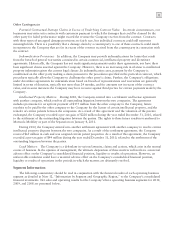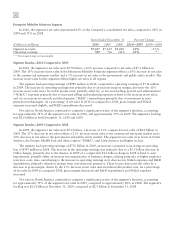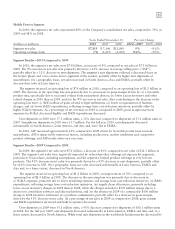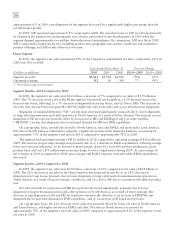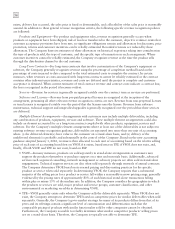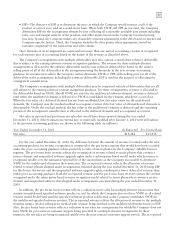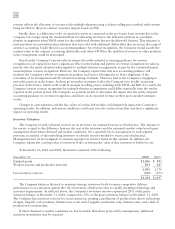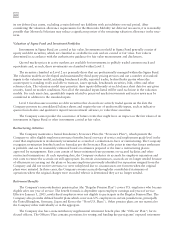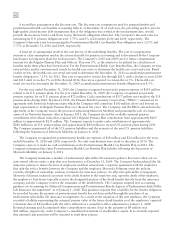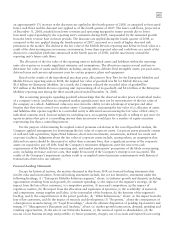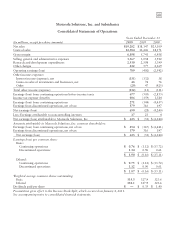Motorola 2010 Annual Report Download - page 69
Download and view the complete annual report
Please find page 69 of the 2010 Motorola annual report below. You can navigate through the pages in the report by either clicking on the pages listed below, or by using the keyword search tool below to find specific information within the annual report.
61
benefits when the participants meet the minimum age and years of service requirements. Elected officers who were
not yet vested in the Officers’ Plan as of December 31, 1999 had the option to remain in the Officers’ Plan or elect
to have their benefit bought out in restricted stock units. Effective December 31, 1999, newly elected officers are not
eligible to participate in the Officers’ Plan. Effective June 30, 2005, salaries were frozen for this plan.
The Company has an additional noncontributory supplemental retirement benefit plan, the Motorola
Supplemental Pension Plan (“MSPP”), which provides supplemental benefits to individuals by replacing the Regular
Pension Plan benefits that are lost by such individuals under the retirement formula due to application of the
limitations imposed by the Internal Revenue Code. However, elected officers who are covered under the Officers’
Plan or who participated in the restricted stock buy-out are not eligible to participate in MSPP. Effective January 1,
2007, eligible compensation was capped at the IRS limit plus $175,000 (the “Cap”) or, for those already in excess
of the Cap as of January 1, 2007, the eligible compensation used to compute such employee’s MSPP benefit for all
future years will be the greater of: (i) such employee’s eligible compensation as of January 1, 2007 (frozen at that
amount), or (ii) the relevant Cap for the given year. Additionally, effective January 1, 2009, the MSPP was frozen to
new participants unless such participation was due to a prior contractual entitlement.
In February 2007, the Company amended the Regular Pension Plan and the MSPP, modifying the definition of
average earnings. For years ended prior to December 31, 2007, benefits were calculated using the rolling average of
the highest annual earnings in any five years within the previous ten calendar year period. Beginning in January
2008, the benefit calculation was based on the set of the five highest years of earnings within the ten calendar years
prior to December 31, 2007, averaged with earnings from each year after 2007. Also effective January 2008, the
Company amended the Regular Pension Plan, modifying the vesting period from five years to three years.
In December 2008, the Company amended the Regular Pension Plan, the Officers’ Plan and the MSPP
(collectively, the “2008 Amended Pension Plans”) such that, effective March 1, 2009: (i) no participant shall accrue
any benefit or additional benefit on or after March 1, 2009, and (ii) no compensation increases earned by a
participant on or after March 1, 2009 shall be used to compute any accrued benefit. In 2008, the Company
recognized a $237 million curtailment gain associated with this plan amendment.
Certain healthcare benefits are available to eligible domestic employees meeting certain age and service
requirements upon termination of employment (the “Postretirement Health Care Benefits Plan”). For eligible
employees hired prior to January 1, 2002, the Company offsets a portion of the postretirement medical costs to the
retired participant. As of January 1, 2005, the Postretirement Health Care Benefits Plan has been closed to new
participants.
Accounting methodologies use an attribution approach that generally spreads individual events over the service
lives of the employees in the plan. Examples of “events” are plan amendments and changes in actuarial assumptions
such as discount rate, expected long-term rate of return on plan assets, and rate of compensation increases. The
principle underlying the required attribution approach is that employees render service over their service lives on a
relatively consistent basis and, therefore, the income statement effects of pension benefits or postretirement health
care benefits are earned in, and should be expensed in, the same pattern.
There are various assumptions used in calculating the net periodic benefit expense and related benefit
obligations. One of these assumptions is the expected long-term rate of return on plan assets. The required use of
the expected long-term rate of return on plan assets may result in recognized pension income that is greater or less
than the actual returns of those plan assets in any given year. Over time, however, the expected long-term returns
are designed to approximate the actual long-term returns and therefore result in a pattern of income and expense
recognition that more closely matches the pattern of the services provided by the employees. Differences between
actual and expected returns are recognized in the net periodic pension calculation over five years.
The Company uses long-term historical actual return experience with consideration of the expected investment
mix of the plans’ assets, as well as future estimates of long-term investment returns, to develop its expected rate of
return assumption used in calculating the net periodic pension cost and the net retirement healthcare expense. The
Company’s investment return assumption for the Regular Pension Plan and Postretirement Healthcare Benefits Plan
was 8.25% in both 2010 and 2009. The investment return assumption for the Officers’ Plan was 6% in both 2010
and 2009. At December 31, 2010, the Regular Pension Plan and the Postretirement Health Care Benefits Plan
investment portfolios were predominantly equity investments and the Officers’ Plan investment portfolio was
predominantly fixed-income securities.


